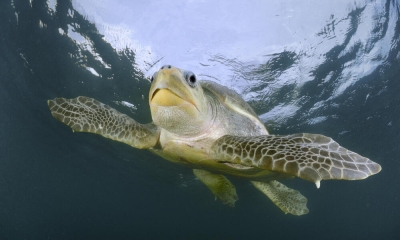
Olive ridleys are considered the most abundant sea turtle in the world. They get their name from the coloring of their heart-shaped shell, which starts out gray but becomes olive green once the turtles are adults. They have one to two visible claws on each of their paddle-like flippers. Western Atlantic olive ridleys usually have a darker coloration than eastern Pacific olive ridleys. Adult turtles are relatively small, averaging 2 to 2.5 feet (0.6 to 0.7 meters) in length and weighing 80 to 110 pounds (36 to 49 kilograms). The largest of these animals are observed on the Pacific coast of Mexico.
The olive ridley is found in the tropical regions of the Pacific, Atlantic, and Indian Oceans. In the Pacific, it prefers beaches of Mexico south to Colombia. In the Indian Ocean, its greatest abundance is in eastern India and Sri Lanka. Only a small and declining population of olive ridleys nest in the western Atlantic along the western coast of Africa.
Olive ridleys do not nest along coastal beaches of the United States, but do utilize waters of the southwestern U.S., and sometimes north to the Oregon coast during feeding migration. The olive ridley appears to be more of an open ocean inhabitant, unlike the Kemp’s ridley, which primarily inhabits shallow nearshore coastal waters.
The olive ridley is omnivorous, meaning it feeds on both plants and animals, including algae, lobster, crabs, tunicates, mollusks, shrimp, and fish. Olive ridleys can be found foraging for invertebrates to depths of about 500 feet (150 meters).
Credit : National Wildlife Federation
Picture Credit : Google




